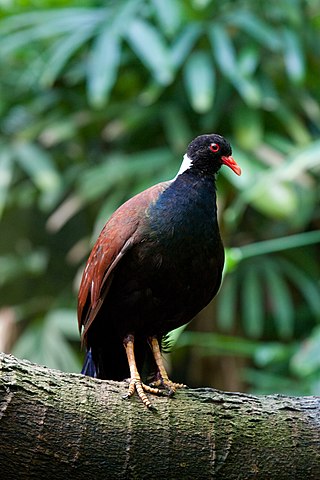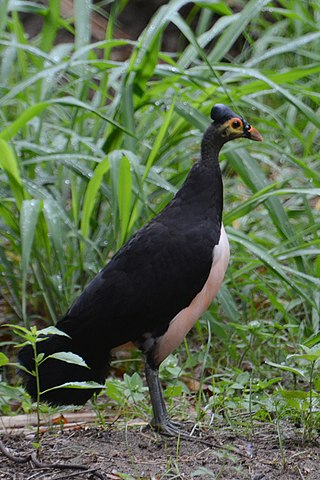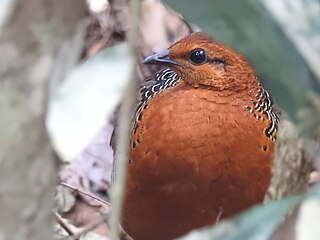
A partridge is a medium-sized galliform bird in any of several genera, with a wide native distribution throughout parts of Europe, Asia and Africa. Several species have been introduced to the Americas. They are sometimes grouped in the Perdicinae subfamily of the Phasianidae. However, molecular research suggests that partridges are not a distinct taxon within the family Phasianidae, but that some species are closer to the pheasants, while others are closer to the junglefowl.

The grey partridge, also known as the gray-legged partridge, English partridge, Hungarian partridge, or hun, is a gamebird in the pheasant family Phasianidae of the order Galliformes, gallinaceous birds. The scientific name is the Latin for "partridge", and is itself derived from Ancient Greek perdix.

The pheasant pigeon is a species of large terrestrial pigeon. It is the only species of the monotypic genus Otidiphaps. The pheasant pigeon is found in the primary rainforests of New Guinea and nearby islands. It ranges primarily over hilly and lower mountain areas, but can also be found in lowlands.

The snowcocks or snowfowl are a group of bird species in the genus Tetraogallus of the pheasant family, Phasianidae. They are ground-nesting birds that breed in the mountain ranges of southern Eurasia from the Caucasus to the Himalayas and western China. Some of the species have been introduced into the United States. Snowcocks feed mainly on plant material.

The Chinese bamboo partridge is a small Galliform bird. It is one of three species in the genus Bambusicola, along with the mountain bamboo partridge of the Himalayas, and the Taiwan bamboo partridge of Taiwan. Chinese bamboo partridge is a monotypic species.

Cabot's tragopan is a pheasant found in south-east China. The common and scientific names of this large bird both commemorate the ornithologist Samuel Cabot III. Other common names include the Chinese tragopan and the yellow-bellied tragopan. The population is divided into two subspecies, of which the dominant subspecies is found in the provinces of Fujian, Jiangxi, Zhejiang, and Guangdong, and T. c. guangxiensis is confined to northeastern Guangxi and southern Hunan. The IUCN has assessed it as being a "vulnerable species".

The spotted wood quail is a small ground-dwelling bird in the New World quail family. It is a resident breeder in the mountains of Central America from southern Mexico to western Panama.

The maleo is a large megapode and the only member of the monotypic genus Macrocephalon. The maleo is endemic to Sulawesi and the nearby smaller island of Buton in Indonesia. It is found in the tropical lowland and hill forests, but nests in the open sandy areas, volcanic soils, or beaches that are heated by the sun or geothermal energy for incubation.

The Abyssinian ground thrush is a thrush from the family Turdidae which is native to north-east Africa where it lives at high altitude in montane forests.

The Arabian partridge is a species of bird in the family Phasianidae, native to the southern Arabian peninsula. Two subspecies are recognised, A. m. melanocephala and A. m. guichardi. It sometimes hybridises with Philby's partridge and with the rock partridge.

The red-breasted partridge, also known as the Bornean hill-partridge, is a species of bird in the family Phasianidae. It is endemic to hill and montane forest in Borneo, preferring bamboos and thickets. The International Union for Conservation of Nature (IUCN) has assessed it as a least-concern species.

The rufous-throated partridge is a species of bird in the family Phasianidae. It is found in montane forests in India and Southeast Asia. The International Union for Conservation of Nature (IUCN) has assessed it as a least-concern species.

Bamboo partridges, sometimes called ridge partridges, are medium-sized non-migratory birds of the genus Bambusicola in the family Phasianidae.They have a wide native distribution throughout Asia. They were formerly grouped in the Perdicinae subfamily of the Phasianidae. However, molecular research suggests that partridges are not a distinct taxon within the family Phasianidae, but that some species are closer to the pheasants, while others are closer to the junglefowl. Phylogenetic evidence supports the bamboo partridges as being the sister genus to the junglefowl.

The ferruginous partridge is a species of bird in the family Phasianidae. It belongs to the monotypical genus Caloperdix. It is found in Indonesia, Malaysia, Myanmar, and Thailand.

The crimson-headed partridge is a species of bird in the pheasant, partridge, and francolin family Phasianidae. Described by the British ornithologist Richard Bowdler Sharpe in 1879, it is the only species in the genus Haematortyx. It is endemic to Borneo, where it inhabits lower montane forest in the northern and central parts of the island. It is mainly found at elevations of 1,000–1,700 m (3,300–5,600 ft), but can be seen as low as 185 m (607 ft) and as high as 3,050 m (10,010 ft). Adult males have a striking appearance, with a dark blackish body and crimson red heads, necks, breasts, and undertail coverts. Females have a similar pattern, but with duller brownish-black colouration, orangish-red heads and breasts, and a brownish-black bill instead of a yellowish one. Juveniles are duller and have the crimson restricted to the top of the head.

The fasciated antshrike is a species of bird in the antbird family Thamnophilidae. The species is found in Central and Southern America.

The blackish tapaculo is a species of bird in the family Rhinocryptidae. It is found in Colombia, Ecuador, Peru, and Venezuela.

The sooty grouse is a species of forest-dwelling grouse native to North America's Pacific Coast Ranges. It is closely related to the dusky grouse, and the two were previously considered a single species, the blue grouse.

Perdicinae is a polyphyletic former subfamily of birds in the pheasant family, Phasianidae, regrouping the partridges, Old World quails, and francolins. Although this subfamily was considered monophyletic and separated from the pheasants, tragopans, junglefowls, and peafowls (Phasianinae) till the early 1990s, molecular phylogenies have shown that these two subfamilies actually constitute only one lineage. For example, some partridges are more closely affiliated to pheasants, whereas Old World quails and partridges from the Alectoris genus are closer to junglefowls. Due to this, the subfamily Perdicinae is no longer recognized by the International Ornithological Congress, with the species being split among 3 subfamilies.

The Talamanca hummingbird or admirable hummingbird is a species of hummingbird in the "mountain gems", tribe Lampornithini in subfamily Trochilinae. It is found in Costa Rica and Panama.





















